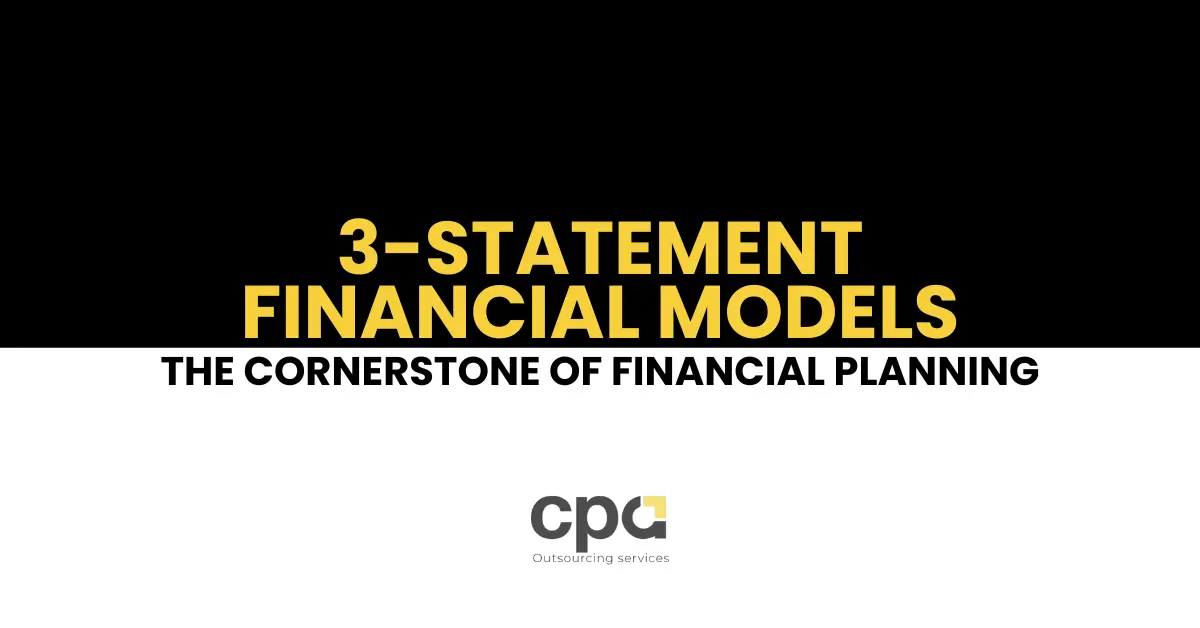3-Statement Financial Models: The Cornerstone of Financial Planning

When you’re running a business, it’s easy to get lost in the numbers. You have cash coming in, bills going out, sales projections, and growth plans all swirling around. But how do you make sense of it all in a way that shows the true financial health of your company?
That’s where a 3-statement financial model comes in. It ties together your income statement, balance sheet, and cash flow statement into one unified framework. Think of it as the GPS of financial planning it doesn’t just tell you where you are today; it maps where you’re going and helps you avoid roadblocks along the way.
In this blog, we’ll dive into what a 3-statement financial model is, why it matters, how integrated forecasting makes it more powerful, and how US companies whether startups or large corporations can use it for smarter decision-making.
What Is a 3-Statement Financial Model?
At its core, a 3-statement financial model connects three key reports:
- Income Statement (Profit & Loss): Shows revenues, expenses, and profits.
- Balance Sheet: Displays assets, liabilities, and shareholder equity at a point in time.
- Cash Flow Statement: Tracks the actual cash movement what’s coming in and what’s going out.
Instead of looking at these reports separately, the 3-statement financial model integrates them into one connected system. For example, if your revenue grows on the income statement, it flows into net income, which then affects retained earnings on the balance sheet and operating cash flow.
This creates a domino effect where every assumption you change like sales growth, cost of goods sold, or hiring expenses ripples across all three statements.
Why Businesses Need a 3-Statement Financial Model
Many small and mid-sized companies think financial models are only for big corporations or venture-backed startups. But that’s not true. Whether you’re a small retailer in Chicago or a manufacturing company in Texas, a 3-statement financial model gives you the visibility you need to make informed decisions.
Here are the biggest benefits:
1. Better Cash Management
Cash is king in business. You might be profitable on paper, but if your clients pay late or inventory sits on shelves, you can run into cash shortages. With integrated forecasting, your 3-statement model shows how revenue delays impact your ability to pay suppliers, salaries, or loans.
For instance, a construction startup bidding on projects in Florida can forecast how delays in client payments affect its ability to buy materials. This insight could help them secure a line of credit before problems arise.
2. Smarter Fundraising Conversations
Investors and banks don’t just want numbers they want a story backed by logic. A well-built 3-statement financial model shows them how your revenue growth translates into profitability and sustainable cash flow.
A SaaS company in California raising $5M in Series A funding can present an integrated forecasting model showing how increased customer acquisition leads to recurring revenue, which covers operating costs within 18 months.
3. Improved Scenario Planning
What if you expand into a new market? What if your supplier raises prices by 10%? A good 3-statement financial model lets you run “what-if” scenarios to understand the impact.
A food distributor in New York considering importing from new suppliers can forecast how currency fluctuations affect both cash flow and net income.
The Role of Integrated Forecasting
Forecasting sales alone isn’t enough. That’s why integrated forecasting tying income, balance sheet, and cash flow forecasts together is crucial.
With integrated forecasting, you can see how:
- Increased sales create more receivables on the balance sheet.
- More receivables reduce cash flow until payments are collected.
- Higher inventory purchases affect both cash flow and liabilities.
- This interconnected view prevents decision-makers from being blindsided.
Imagine a medical device startup in Boston projecting $10M in sales. Without integrated forecasting, they may not realize that rapid growth requires upfront inventory spending, which could strain their cash. A proper model shows this and helps them plan financing.
Common Mistakes Businesses Make
Even with the best intentions, businesses often stumble when building a 3-statement financial model. Here are some pitfalls to avoid:
- Overly optimistic revenue projections – Assuming every lead converts into sales is a recipe for disaster.
- Ignoring working capital – Not accounting for receivables, payables, and inventory creates inaccurate forecasts.
- Static assumptions – Using fixed percentages instead of dynamic drivers (like headcount linked to sales growth).
- Not linking all three statements properly – If net income doesn’t flow into retained earnings, the model is broken.
How CPA Outsourcing Services Can Help
At CPA Outsourcing Services, we’ve worked with startups, SMBs, and even Fortune 500 subsidiaries to build tailored 3-statement financial models.
Our team ensures that your model isn’t just numbers in a spreadsheet but a living tool for decision-making. Whether you’re seeking investment, managing rapid growth, or staying compliant with state and federal reporting standards, we create models that give you clarity and confidence.
With integrated forecasting, you’ll be equipped to:
- Present investor-ready financials.
- Secure loans with credible projections.
- Plan expansions without cash surprises.
- Stay compliant with US accounting standards.
Final Thoughts
A 3-statement financial model is more than just a financial document it’s a roadmap for the future of your business. By integrating income, balance sheet, and cash flow forecasts, you gain a holistic view of your company’s performance and sustainability.
Whether you’re a startup looking for investors or an established company planning your next big move, having a robust model with integrated forecasting is non-negotiable.
At CPA Outsourcing Services, we specialise in creating models that aren’t just technically sound but also easy to understand, so you and your stakeholders can make smarter decisions.
